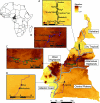Chromosomal inversions, natural selection and adaptation in the malaria vector Anopheles funestus
- PMID: 20837604
- PMCID: PMC3002248
- DOI: 10.1093/molbev/msq248
Chromosomal inversions, natural selection and adaptation in the malaria vector Anopheles funestus
Abstract
Chromosomal polymorphisms, such as inversions, are presumably involved in the rapid adaptation of populations to local environmental conditions. Reduced recombination between alternative arrangements in heterozygotes may protect sets of locally adapted genes, promoting ecological divergence and potentially leading to reproductive isolation and speciation. Through a comparative analysis of chromosomal inversions and microsatellite marker polymorphisms, we hereby present biological evidence that strengthens this view in the mosquito Anopheles funestus s.s, one of the most important and widespread malaria vectors in Africa. Specimens were collected across a wide range of geographical, ecological, and climatic conditions in Cameroon. We observed a sharp contrast between population structure measured at neutral microsatellite markers and at chromosomal inversions. Microsatellite data detected only a weak signal for population structuring among geographical zones (F(ST) < 0.013, P < 0.01). By contrast, strong differentiation among ecological zones was revealed by chromosomal inversions (F(ST) > 0.190, P < 0.01). Using standardized estimates of F(ST), we show that inversions behave at odds with neutral expectations strongly suggesting a role of environmental selection in shaping their distribution. We further demonstrate through canonical correspondence analysis that heterogeneity in eco-geographical variables measured at specimen sampling sites explained 89% of chromosomal variance in A. funestus. These results are in agreement with a role of chromosomal inversions in ecotypic adaptation in this species. We argue that this widespread mosquito represents an interesting model system for the study of chromosomal speciation mechanisms and should provide ample opportunity for comparative studies on the evolution of reproductive isolation and speciation in major human malaria vectors.
Figures



References
-
- Balanya J, Serra L, Gilchrist GW, Huey RB, Pascual M, Mestres F, Sole E. Evolutionary pace of chromosomal polymorphism in colonizing populations of Drosophila subobscura: an evolutionary time series. Evolution. 2003;57:1837–1845. - PubMed
-
- Beaumont MA. Adaptation and speciation: what can F-st tell us? Trends Ecol Evol. 2005;20:435–440. - PubMed
-
- Beaumont MA, Balding DJ. Identifying adaptive genetic divergence among populations from genome scans. Mol Ecol. 2004;13:969–980. - PubMed
-
- Beaumont MA, Nichols R. Evaluating loci for use in the genetic analysis of population structure. Proc R Soc Lond Ser B Biol Sci. 1996;263:1619–1626.
-
- Besansky NJ, Krzywinski J, Lehmann T, Simard F, Kern M, Mukabayire O, Fontenille D, Toure Y, Sagnon NF. Semipermeable species boundaries between Anopheles gambiae and Anopheles arabiensis: evidence from multilocus DNA sequence variation. Proc Natl Acad Sci U S A. 2003;100:10818–10823. - PMC - PubMed
Publication types
MeSH terms
Grants and funding
LinkOut - more resources
Full Text Sources
Miscellaneous

